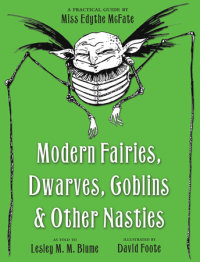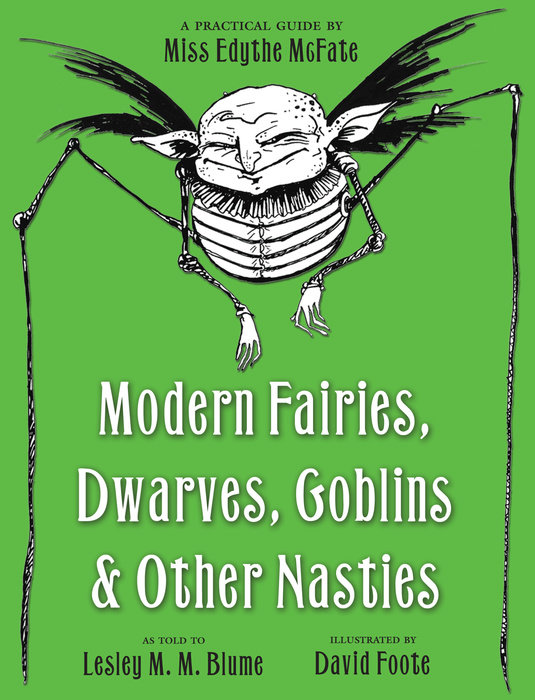Modern Fairies, Dwarves, Goblins, and Other Nasties: A Practical Guide by Miss Edythe McFate
Perhaps you think fairies are figments of the imagination, or even relics of an ancient past. You may even think all fairies are lovely winged creatures, who dance in bluebell fields, granting wishes to anyone who should encounter them.
You would be wrong on all counts.
Fairies are very much alive today, and they are everywhere—in our cities, our backyards, and even our kitchen cupboards. Some of them are indeed the sweet-tempered, winged creatures of folklore, but the fairy family also includes goblins, trolls, brownies, and other strange creatures, some of which are revealed to humans in this book for the very first time. While many fairy breeds are harmless, others can be quite nasty or even dangerous.
In this luxuriously illustrated guidebook, preeminent fairy expert Miss Edythe McFate shares her knowledge of the modern fairy world and includes practical advice on matters such as how to tell a good fairy from a bad one, how to spot a “fairy ring,” how to tell the difference between dwarves and trolls (one species isfar deadlier than the other), and how to defend against fairies who would do you harm. Also included are eight true cautionary tales about children who have encountered fairies in ultramodern New York City.
You would be wise to read closely, lest you find yourself in your own fairy encounter, for as Miss Edythe McFate reminds us, “Forewarned is forearmed.”
An Excerpt fromModern Fairies, Dwarves, Goblins, and Other Nasties: A Practical Guide by Miss Edythe McFate
The War at the Algonquin Hotel
You've likely heard of the famous Algonquin Hotel on Manhattan's West 44th Street, which sits like a tired, dignified old man with his back turned to the nearby carnival of Times Square.
There was always something shady and calm about the Algonquin, which makes sense when you think about it. After all, hundreds of years ago, a magnificent oak tree lived where the hotel now stands.
But then along came settlers, who eventually decided that they needed hotels with things like claw-footed bathtubs and room service. And so they raised their axes, and many thousands of chops and hacks later, the magnificent oak tree was gone and its woodwas made into the frame of the Algonquin Hotel.
It used to be quite a peculiar place. When you pushed through the heavy glass-and-oak doors into the lobby, the air grew heavier and wreathed around your shoulders like a fur shawl. This was all very strange until you realized that this is what it feels like when time is slowing down.
If you needed proof that this was happening, you could have watched the old grandfather clock facing the concierge desk, which sighed rather than chimed; its spindly hands circled the yellowing clock face more slowly than the hands of every other clockin the world, and yet somehow the time was always right. A teacup that fell in the Algonquin took longer to hit the floor than anyplace else in the world.
The Algonquin still managed to run like a normal hotel, despite the honey-in-winter pace of life there. Somehow towels got washed and pressed and arrived with lavender sweetness in all of the bathrooms; crisp newspapers appeared outside the door of each room at dawn; hot meals were turned out of the kitchen in a timely manner, although usually in need of a little salt. But no one at the Algonquin could figure out exactly how things ran so smoothly.
Not the ancient, white-gloved waiters, most of whom were as old as the grandfather clock; nor the kitchen staff; nor the chambermaids; and certainly not the sleepy, disheveled manager of the hotel, Mr. Harold Kneebone. When pressed on the subject, Mr.Kneebone would always say:
"Who can say for sure what makes the clock tick, or the sun rise and set, or the wheat grow? These things just happen, that's all."
And then, more often than not, he would nestle his face into his forearms and sail off into a soulful, sweet little nap.
However, two Algonquin residents understood exactly why the establishment ran like clockwork.
The first was a big, fat orange cat with yellow eyes named Mathilde, who lived in a little diorama of a room carved into one of the lobby walls. A golden-lettered wooden sign dangled above the cubby and proclaimed:
Mathilde's Suite
And the second resident in the know was Olive, the eight-year-old daughter of the hotel chef.
Olive was especially good at two things: making fruit salads and keeping secrets. Mathilde was her best friend, and when fruit-salad duty didn't keep Olive in the kitchen, the girl and the cat sat in their favorite corner of the lobby behind a potted palm.
One evening, the old headwaiter peeked around the palm to see what they were up to. Their heads were turning from side to side in unison.
"What are you looking at, an invisible tennis match?" asked the headwaiter warily.
"Nope," said Olive.
"Well, what, then?" pressed the headwaiter.
Mathilde settled her chin onto her paws, her yellow eyes tracing invisible mice darting across the floor.
"Just looking around," Olive responded mysteriously.
Not that the headwaiter would have believed Olive if she'd told him the truth: that she and Mathilde were watching brownies.
Not many people today are familiar with brownies, indisputedly the friendliest species of fairy. Tiny, wingless creatures, brownies wear hats made from nutshells and dapper little three-piece suits and have a gentle sort of magic mostly used for practical jokes.
Usually found in places where large operations are going on, like factories and, of course, hotels, brownies always like to run things--whether they've been invited to help or not. They adhere to strict routines, which makes them excellent workers. But be warned: nothing makes a brownie behave more badly than a disrupted routine.
In the old days, brownies lived in trees and when they died, their spirits became one with those trees. Generations of brownies had lived in the Algonquin oak tree before it got chopped up and made into the hotel itself. Since then, the descendants of the original Algonquin brownies had adopted the hotel as their home, and as you probably guessed, those brownies--not the old waiters or Mr. Kneebone--were the ones running the establishment so well.

